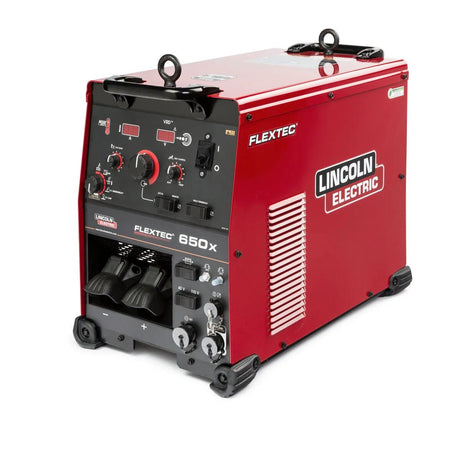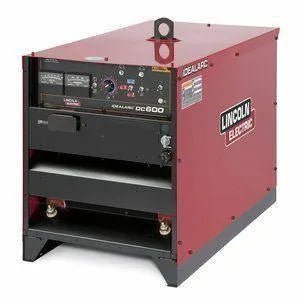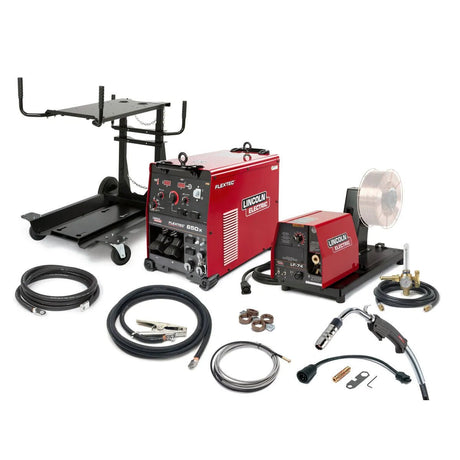Explore high-performance submerged arc welding (SAW) equipment for heavy fabrication. Achieve deep penetration, clean welds, and high deposition rates with automated or manual sub arc welders—ideal for shipbuilding, construction, pipelines, and large-scale steel projects.
-
Lincoln Flextec 650X Multi-Process Welder with CrossLinc Technology - K3425-1
$9,477.25$10,507.00Unit price /Unavailable -
Lincoln Flextec 650X Multi-Process Welder with CrossLinc / LF-74 HD One-Pak - K3513-1
$16,359.00$18,136.00Unit price /Unavailable -
Lincoln Power Wave AC/DC 1000SD Advanced Submerged Arc Welder - K2803-1
$54,754.39$57,253.52Unit price /Unavailable -
Lincoln Idealarc DC600 220/380/440 3/50/60 (Not Available in US) - K1365-23
$13,555.80Unit price /Unavailable -
Lincoln Flextec 650X Multi-Process Welder with CrossLinc / LF-74 Ready-Pak - K3512-1
$15,241.20$16,897.00Unit price /Unavailable -
Lincoln Idealarc DC600 Multi-Process Welder - K1288-17
$11,393.31$12,947.00Unit price /Unavailable -
Lincoln Flextec 650X Multi-Process Welder with CrossLinc / Flex Feed 84 One-Pak - K3514-1
$14,720.57$16,320.00Unit price /Unavailable -
Lincoln Idealarc AC1200 Subarc Welder - K3140-2
$43,017.26$47,691.00Unit price /Unavailable -
Lincoln Power Wave AC/DC 1000SD Advanced Sub Arc Factory Demo Welder - U2803-1
$45,999.00$53,458.00Unit price /Unavailable -
Lincoln Idealarc DC600 220/380/440 3/50/60 (Not Available in US) - K1365-24
$16,006.77Unit price /Unavailable -
Lincoln Idealarc DC600 Multi-Process Welder - K1288-22
$12,221.46$13,549.00Unit price /Unavailable -
Lincoln Idealarc DC600 Multi-Process Welder with Multi-Process Switch - K1288-18
$12,399.29$14,090.00Unit price /Unavailable -
Lincoln Idealarc DC-1000 Subarc Welder - K1386-4
$27,898.38$30,929.00Unit price /Unavailable -
Lincoln Idealarc DC-1000 Multi-Process Welder Not available in the US - K1387-6
$25,999.60$27,368.00Unit price /Unavailable -
Lincoln IDEALARC DC-1000 Multi-Process Welder Export Only - K1387-3
$24,974.70Unit price /Unavailable -
Lincoln IDEALARC DC-1500 Multi-Process Welder Export Only - K1383-4
$48,176.95Unit price /Unavailable -
Lincoln Idealarc DC-1500 Submerged Arc Welder - K1275
$46,168.19$51,184.00Unit price /Unavailable -
Lincoln Idealarc DC-1000 Subarc Welder - K1386-3
$24,438.02$27,093.00Unit price /Unavailable -
Lincoln Factory Demo Idealarc DC-1000 Subarc Welders - U1386-3
$19,635.00$24,147.19Unit price /Unavailable -
Lincoln Factory Demo Idealarc DC1500 Subarc Welder - U1275
$38,165.00$45,618.70Unit price /Unavailable
The Essential Guide to Submerged Arc Welding: Techniques and Applications
Introduction to Submerged Arc Welding (SAW)
Definition and Overview
This method is designed to improve the quality and efficiency of welding, particularly for heavy applications. Submerged arc welding—commonly referred to as sub arc, subarc, or SAW—is an arc welding process known for its effectiveness in joining thick materials like steel. Unlike traditional welding techniques, submerged arc welding uses a continuously fed consumable electrode and a blanket of granular flux. This process supports the joining of various metal forms, including steel. This flux covers the welding arc and molten weld pool, shielding them from atmospheric contamination, reducing sparks, and minimizing UV radiation. The result is a smooth, high-quality weld with deep penetration, ideal for heavy industrial applications. Such arc welding methods are essential in heavy-duty metal welding.
Importance in Modern Welding Techniques
SAW holds a significant place in modern fabrication due to its high deposition rates, consistency, and ability to be easily automated. Its robust performance makes it a preferred choice in industries where large structures are fabricated, allowing for efficient production without compromising weld strength or quality. Submerged arc welding also reduces the need for skilled manual operators because much of the process can be mechanized, streamlining both production and training requirements. This feature makes SAW machines highly valued in modern industrial settings. Most notably, sub arc welders are flexible, accommodating a range of welding projects with ease. It offers a way to increase productivity while maintaining high-quality standards. Submerged arc helps in achieving thorough penetration even when welding thick plate materials with ease.
How Submerged Arc Welding Works
The Welding Process Explained
The fundamental principle behind the SAW process involves generating an arc between a continuously fed wire electrode and the workpiece, with great control over power and current parameters. As the welding operation begins, the flux, a crucial component, is poured over the joint area, fully submerging the arc and melting the wire. This method is ideal for achieving strong, clean welds with minimal manual intervention, particularly useful in cutting areas of thick metal. The electric arc melts both the electrode and the base metal, forming a molten weld pool beneath the flux layer. This operation requires advanced control over heat and current to ensure optimal results. The flux serves multiple purposes: protecting the weld from atmospheric contamination, forming the weld bead, and stabilizing the arc while also accounting for the flux's composition. It is critical in creating high-quality welds by managing the deposition process.
Key Components Involved
To perform submerged arc welding, several essential components are required to provide support and structure:.
- Power Sources: Provide the necessary current for welding, creating a stable arc for efficient operation.
- Power sources are versatile and can be tailored to different welding needs.
- Wire Electrode: Continuously fed consumable wire, acting both as filler material and electrode, is vital for efficient material deposition in subarc welding applications.
- Flux Hopper: Dispenses a consistent layer of granular flux over the welding area. These Accessories ensure a steady application of flux, enhancing the weld process.
- Submerged Arc Welder Machine: May be manual, semi-automatic, or fully automated, these machines include brands like Miller and offer precision in welding.
- Available for both manual and automated systems, submerged arc welders are designed to meet diverse welding needs.
- Travel Carriage: A travel carriage efficiently moves the welding head along the seam, even on single pipes, for long continuous welds, common in automated setups.
- Moves the welding head along the seam for long welds, common in automated setups. The travel carriage provides precise movement and position control, crucial for long, uniform welds.
These components work together to ensure stable arc operation, efficient material deposition, and optimal weld quality. These systems are designed to provide consistent performance and help in managing heavy-duty fabrication projects efficiently.
Advantages and Disadvantages of SAW
Submerged arc welding is valued for its numerous benefits:
Submerged arc welding is valued for its:
- High Efficiency: Rapid welding speeds and deep weld penetration allow for thicker sections to be joined in less time. This method effectively handles thick steel, reducing the need for additional process steps. Excellent Weld Quality: The protective flux reduces impurities, spatter, and defects, resulting in clean, strong welds. Minimal Operator Intervention: The process readily lends itself to automation, increasing production rates and reducing labor costs.
- This reduces the need for additional operators and enhances overall production, ensuring low costs in extensive operations.
- Reduced Fumes and Arc Radiation: The flux blanket keeps harmful emissions and intense light to a minimum, enhancing workplace safety.
Limitations and Challenges
However, SAW presents some challenges:
- Limited to Flat or Horizontal Welding: The process is not suitable for vertical or overhead positions due to the granular nature of the flux. Flat and horizontal welding positions allow for deep penetration, beneficial for steel fabrication. Bulkier Equipment: The required automation and flux delivery systems can be cumbersome, particularly in tight working spaces.
- Material Restrictions: SAW is most effective on steel and certain alloys; it is less suited for thin materials or non-ferrous metals, although the use of cored wire can aid in welding more challenging compositions.
- The use of cored wire can enable the welding of stainless steels and other challenging alloys. Flux Handling: Management of slag and used flux is necessary to maintain weld quality and prevent contamination. Managing additional sediment from slag can improve the efficiency of SAW systems.
Applications of Submerged Arc Welding
Industries That Utilize SAW
Because of its speed and weld quality, SAW systems are widely used in sectors such as:
- Shipbuilding: For fabricating hulls and structural frames, handling thick metal efficiently.
- Automotive Manufacturing: In heavy truck frames and chassis, subarc welding provides the strength and durability needed for demanding manufacturing processes.
- Construction: When building bridges, beams, and structural columns. Pipe and Pressure Vessel Fabrication: For consistent, deep welds in thick-walled cylinders and pipelines, by utilizing efficient gas shielding.
Specific Use Cases in Heavy Fabrication
Some notable examples of SAW in action include:
- Welding longitudinal and circumferential seams on large steel pipes. Joining heavy-gauge steel plates for the construction of storage tanks. Fabricating girders and trusses for infrastructure projects. Manufacturing railroad tracks and heavy equipment frames. Subarc welding, with its digital controls, is capable of producing quality welds demanded by complex engineering projects.
Equipment and Techniques for Efficient SAW
Necessary Tools for SAW
To achieve optimal results, the following equipment is commonly used for subarc welding:
- Submerged arc welder (manual or automatic)
- Wire feeders and reels
- Flux dispensing and recovery systems
- Welding heads (for single or multi-wire operation)
- Oscillators and travel carriages for automated welding
Techniques to Optimize the Welding Process
Weld quality, productivity, and consistency in SAW can be enhanced by:
- Automating the Process: Digital automation involving programmable carriages and heads allows for precise movement and speed control.
- Utilizing programmable carriages and heads for precise movement and speed control. Multi-Wire Welding: Feeding multiple electrodes simultaneously to boost deposition rates. Controlling Parameters: Adjusting current, voltage, travel speed, and electrode stick-out to match the material thickness and desired weld profile.
- Flux Selection: Choosing the appropriate flux composition to improve slag detachability, mechanical properties, and weld appearance is crucial for sub arc welding.
- Pre- and Post-Weld Treatments: Employing preheating, interpass temperature control, and post-weld heat treatments, especially for thicker or alloyed materials.
By carefully selecting the right equipment and adhering to best practices, sub arc welding can deliver reliable, high-strength joints across a wide range of heavy industry applications.
The Essential Guide to Submerged Arc Welding: Techniques and Applications
Introduction to Submerged Arc Welding (SAW)
Definition and Overview
This method is designed to improve the quality and efficiency of welding, particularly for heavy applications. Submerged arc welding—commonly referred to as sub arc, subarc, or SAW—is an arc welding process known for its effectiveness in joining thick materials like steel. Unlike traditional welding techniques, submerged arc welding uses a continuously fed consumable electrode and a blanket of granular flux. This process supports the joining of various metal forms, including steel. This flux covers the welding arc and molten weld pool, shielding them from atmospheric contamination, reducing sparks, and minimizing UV radiation. The result is a smooth, high-quality weld with deep penetration, ideal for heavy industrial applications. Such arc welding methods are essential in heavy-duty metal welding.
Importance in Modern Welding Techniques
SAW holds a significant place in modern fabrication due to its high deposition rates, consistency, and ability to be easily automated. Its robust performance makes it a preferred choice in industries where large structures are fabricated, allowing for efficient production without compromising weld strength or quality. Submerged arc welding also reduces the need for skilled manual operators because much of the process can be mechanized, streamlining both production and training requirements. This feature makes SAW machines highly valued in modern industrial settings. Most notably, sub arc welders are flexible, accommodating a range of welding projects with ease. It offers a way to increase productivity while maintaining high-quality standards. Submerged arc helps in achieving thorough penetration even when welding thick plate materials with ease.
How Submerged Arc Welding Works
The Welding Process Explained
The fundamental principle behind the SAW process involves generating an arc between a continuously fed wire electrode and the workpiece, with great control over power and current parameters. As the welding operation begins, the flux, a crucial component, is poured over the joint area, fully submerging the arc and melting the wire. This method is ideal for achieving strong, clean welds with minimal manual intervention, particularly useful in cutting areas of thick metal. The electric arc melts both the electrode and the base metal, forming a molten weld pool beneath the flux layer. This operation requires advanced control over heat and current to ensure optimal results. The flux serves multiple purposes: protecting the weld from atmospheric contamination, forming the weld bead, and stabilizing the arc while also accounting for the flux's composition. It is critical in creating high-quality welds by managing the deposition process.
Key Components Involved
To perform submerged arc welding, several essential components are required to provide support and structure:.
- Power Sources: Provide the necessary current for welding, creating a stable arc for efficient operation.
- Power sources are versatile and can be tailored to different welding needs.
- Wire Electrode: Continuously fed consumable wire, acting both as filler material and electrode, is vital for efficient material deposition in subarc welding applications.
- Flux Hopper: Dispenses a consistent layer of granular flux over the welding area. These Accessories ensure a steady application of flux, enhancing the weld process.
- Submerged Arc Welder Machine: May be manual, semi-automatic, or fully automated, these machines include brands like Miller and offer precision in welding.
- Available for both manual and automated systems, submerged arc welders are designed to meet diverse welding needs.
- Travel Carriage: A travel carriage efficiently moves the welding head along the seam, even on single pipes, for long continuous welds, common in automated setups.
- Moves the welding head along the seam for long welds, common in automated setups. The travel carriage provides precise movement and position control, crucial for long, uniform welds.
These components work together to ensure stable arc operation, efficient material deposition, and optimal weld quality. These systems are designed to provide consistent performance and help in managing heavy-duty fabrication projects efficiently.
Advantages and Disadvantages of SAW
Submerged arc welding is valued for its numerous benefits:
Submerged arc welding is valued for its:
- High Efficiency: Rapid welding speeds and deep weld penetration allow for thicker sections to be joined in less time. This method effectively handles thick steel, reducing the need for additional process steps. Excellent Weld Quality: The protective flux reduces impurities, spatter, and defects, resulting in clean, strong welds. Minimal Operator Intervention: The process readily lends itself to automation, increasing production rates and reducing labor costs.
- This reduces the need for additional operators and enhances overall production, ensuring low costs in extensive operations.
- Reduced Fumes and Arc Radiation: The flux blanket keeps harmful emissions and intense light to a minimum, enhancing workplace safety.
Limitations and Challenges
However, SAW presents some challenges:
- Limited to Flat or Horizontal Welding: The process is not suitable for vertical or overhead positions due to the granular nature of the flux. Flat and horizontal welding positions allow for deep penetration, beneficial for steel fabrication. Bulkier Equipment: The required automation and flux delivery systems can be cumbersome, particularly in tight working spaces.
- Material Restrictions: SAW is most effective on steel and certain alloys; it is less suited for thin materials or non-ferrous metals, although the use of cored wire can aid in welding more challenging compositions.
- The use of cored wire can enable the welding of stainless steels and other challenging alloys. Flux Handling: Management of slag and used flux is necessary to maintain weld quality and prevent contamination. Managing additional sediment from slag can improve the efficiency of SAW systems.
Applications of Submerged Arc Welding
Industries That Utilize SAW
Because of its speed and weld quality, SAW systems are widely used in sectors such as:
- Shipbuilding: For fabricating hulls and structural frames, handling thick metal efficiently.
- Automotive Manufacturing: In heavy truck frames and chassis, subarc welding provides the strength and durability needed for demanding manufacturing processes.
- Construction: When building bridges, beams, and structural columns. Pipe and Pressure Vessel Fabrication: For consistent, deep welds in thick-walled cylinders and pipelines, by utilizing efficient gas shielding.
Specific Use Cases in Heavy Fabrication
Some notable examples of SAW in action include:
- Welding longitudinal and circumferential seams on large steel pipes. Joining heavy-gauge steel plates for the construction of storage tanks. Fabricating girders and trusses for infrastructure projects. Manufacturing railroad tracks and heavy equipment frames. Subarc welding, with its digital controls, is capable of producing quality welds demanded by complex engineering projects.
Equipment and Techniques for Efficient SAW
Necessary Tools for SAW
To achieve optimal results, the following equipment is commonly used for subarc welding:
- Submerged arc welder (manual or automatic)
- Wire feeders and reels
- Flux dispensing and recovery systems
- Welding heads (for single or multi-wire operation)
- Oscillators and travel carriages for automated welding
Techniques to Optimize the Welding Process
Weld quality, productivity, and consistency in SAW can be enhanced by:
- Automating the Process: Digital automation involving programmable carriages and heads allows for precise movement and speed control.
- Utilizing programmable carriages and heads for precise movement and speed control. Multi-Wire Welding: Feeding multiple electrodes simultaneously to boost deposition rates. Controlling Parameters: Adjusting current, voltage, travel speed, and electrode stick-out to match the material thickness and desired weld profile.
- Flux Selection: Choosing the appropriate flux composition to improve slag detachability, mechanical properties, and weld appearance is crucial for sub arc welding.
- Pre- and Post-Weld Treatments: Employing preheating, interpass temperature control, and post-weld heat treatments, especially for thicker or alloyed materials.
By carefully selecting the right equipment and adhering to best practices, sub arc welding can deliver reliable, high-strength joints across a wide range of heavy industry applications.






















